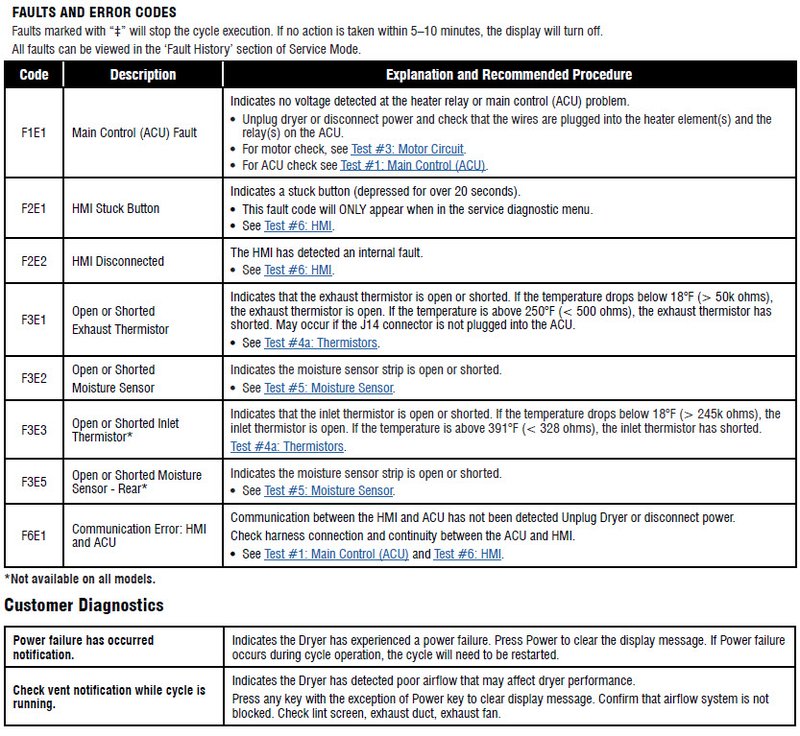
The “E2” error code is Whirlpool’s way of telling you something isn’t quite right with your dryer. Think of it as your dryer’s version of a red flag. It’s a signal that prompts you to pay attention and investigate further. Rather than playing the guessing game of whether it’s a major or minor issue, decoding this message will help you pinpoint the problem and get back to drying your clothes in no time.
Understanding the E2 Error Code
Now, you might be wondering, “What exactly is this E2 error all about?” In simple terms, the E2 error code typically points to a problem with the dryer’s temperature sensor. Imagine the temperature sensor as the dryer’s thermometer, constantly checking if the heat levels are just right. When this sensor isn’t working properly, the dryer can’t keep track of how hot it is inside, leading to potential drying issues or even safety concerns.
But why does a faulty temperature sensor trigger the E2 code? Here’s the deal: If the dryer can’t ensure that the heat is at the right level, it might get overheated or not dry your clothes effectively. This could either damage your clothes or cause the dryer to shut off as a precautionary measure. In essence, the E2 code is like your dryer waving a little caution flag, asking for some attention before things get out of hand.
Okay, so you know it’s about the temperature sensor—but what could have caused it? Sometimes, it’s just a matter of wear and tear. Imagine driving a car with a broken speedometer; you’d have no idea how fast you’re going, which isn’t safe. Similarly, if the temperature sensor fails, your dryer doesn’t know how hot things are getting. Other times, dust, lint, or a loose connection might be the culprits. These can interfere with the sensor’s ability to send accurate readings. The good news? You can often fix these issues without needing to call in a professional.
How to Troubleshoot and Fix the E2 Error Code
So, you’ve got an E2 error code, and you’re wondering how to fix it. Don’t worry; it’s not as daunting as it seems. Let’s tackle this step-by-step, just as if you were following a recipe. First, ensure your dryer is unplugged—that’s like turning off the stove before cooking, a safety must-do. Once it’s unplugged, you’re clear to investigate further.
The initial step is to check for any visible lint or debris that might be affecting the temperature sensor. Think of cleaning the sensor like removing dust from your car’s dashboard; it needs a clear view to function properly. Use a soft cloth or brush to carefully clean around the sensor and ensure it’s free from obstruction. Remember, lint accumulation is a common issue that can easily lead to a misreading.
Next, ensure the sensor is securely connected. Just like how a loose cable can cause your TV to show static, a poor connection can lead to an error code. Gently wiggle the sensor wire to check if it’s loose or disconnected. If it’s not well connected, carefully adjust it until it feels secure. Once you’ve done these checks, plug your dryer back in and give it a test run. If the E2 code disappears, you’ve likely solved the issue. If it doesn’t, it might be time to consider replacing the sensor or consulting a professional.
Preventing Future E2 Errors
Prevention is always better than cure, right? So how can you avoid the hassle of another E2 error in the future? Let’s start with regular maintenance. Just like you’d routinely service your car to keep it running smoothly, your dryer needs some love too. Take time every month to clean the lint trap and inspect the dryer’s interior for any blockages. This not only helps prevent errors but also keeps your dryer working efficiently.
Another tip is to avoid overloading your dryer. Imagine trying to run while carrying a heavy backpack—it’s exhausting. In the same way, an overloaded dryer struggles to function properly, which can lead to overheating and errors. Stick to recommended load sizes to give your appliance an easier time doing its job.
Lastly, consider having a professional check your dryer annually. Think of it like a health check-up, ensuring everything’s in good working condition. A professional can spot potential issues before they become problems, saving you time and stress in the long run. By keeping these preventive measures in mind, you’ll reduce the chances of encountering that pesky E2 error again.
In summary, while seeing an E2 error code might initially cause a bit of panic, it doesn’t have to be a headache. By understanding the role of the temperature sensor, troubleshooting any issues, and maintaining your dryer, you can keep things running smoothly. Your clothes—and your peace of mind—will thank you!